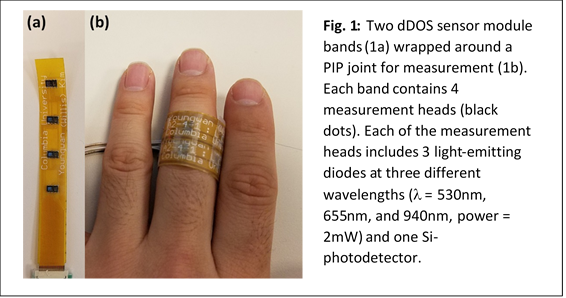Session Information
Date: Sunday, October 21, 2018
Title: Systemic Lupus Erythematosus – Clinical Poster I: Clinical Manifestations and Comorbidity
Session Type: ACR Poster Session A
Session Time: 9:00AM-11:00AM
Background/Purpose: SLE arthritis is difficult to evaluate because of the sometimes-evanescent nature of the symptoms and limitations of physical exams and imaging studies. Dynamic diffuse optical spectroscopy (dDOS) can be used to assess changes in light absorption through tissues during transient venous occlusion. The optical signal reflects changes in blood perfusion and has diagnostic value in rheumatoid arthritis. The current study explored the use of dDOS in SLE arthritis.
Methods: 11 SLE patients (ACR criteria) with active arthritis and 4 controls were evaluated. A dDOS sensor module was developed (Fig. 1). Hemodynamic effects were obtained by inflating a BP cuff to 40 mmHg x 60 seconds. Light at 3 wavelengths (lambda = 530, 655, 940nm) was used to illuminate joints at 8 different points. Transmitted light intensities were measured with Si-photodetectors at 8 other positions (total 8x8x3=192 signal traces). Swollen, tender and healthy joints were examined by the same assessor.
Results: SLE patients and normal controls dDOS data were available for analysis from 66 and 24 proximal interphalangeal (PIP) joints, respectively (PIPs 2-4). Best results were obtained at 530 nm with cuff inflation at 40 mmHg. A representative measurement of 3 SLE arthritis and 3 normal joints is shown in Fig. 2, highlighting differences in rise and plateau time. Given the pronounced effects at lambda = 530nm, we speculate that altered vessel physiology paired with already-increased blood pooling in the affected inflamed joints resulted in quicker increase in light absorption (rise time) that is maintained longer (plateau time) compared to normal joints. The AUC for dDOS was consistent with excellent discrimination, AUC = 0.8639, sensitivity = 76.19, specificity = 88.57 (Fig. 3).
Conclusion: dDOS can evaluate SLE arthritis with high sensitivity and specificity. Rise and plateau time of the optical traces correlate strongly with swollen and tender joint count. The advantages of dDOS are non-invasiveness, objectivity (eliminates inter-rater variability and operator dependency), low cost, and high speed of performance (~5 min per area of scanning) compared to US and MRI. dDOS has the potential to bring much-needed objectivity to the quantification of SLE arthritis.
To cite this abstract in AMA style:
Danias G, Kim Y, Marone A, Neville K, Frantz A, Kapoor T, Geraldino-Pardilla L, Kymissis I, Hielscher A, Askanase A. Diagnosing SLE Arthritis with Dynamic Diffuse Optical Spectroscopy [abstract]. Arthritis Rheumatol. 2018; 70 (suppl 9). https://acrabstracts.org/abstract/diagnosing-sle-arthritis-with-dynamic-diffuse-optical-spectroscopy/. Accessed .« Back to 2018 ACR/ARHP Annual Meeting
ACR Meeting Abstracts - https://acrabstracts.org/abstract/diagnosing-sle-arthritis-with-dynamic-diffuse-optical-spectroscopy/



